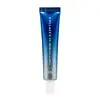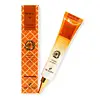What's inside
What's inside
 Key Ingredients
Key Ingredients

No key ingredients
 Benefits
Benefits

 Concerns
Concerns

 Ingredients Side-by-side
Ingredients Side-by-side

Water
Skin ConditioningButylene Glycol
HumectantGlycerin
HumectantHelianthus Annuus Seed Oil
EmollientButyrospermum Parkii Butter
Skin ConditioningCetearyl Alcohol
EmollientDimethicone
EmollientArginine
MaskingGlyceryl Stearate
EmollientCarbomer
Emulsion StabilisingPolysorbate 60
EmulsifyingPEG-100 Stearate
Glyceryl Stearate Se
EmulsifyingCetearyl Olivate
Phenoxyethanol
PreservativeLecithin
EmollientCetearyl Glucoside
EmulsifyingSorbitan Olivate
EmulsifyingChlorphenesin
AntimicrobialStearic Acid
CleansingAllantoin
Skin ConditioningParfum
MaskingXanthan Gum
EmulsifyingAdenosine
Skin Conditioning1,2-Hexanediol
Skin ConditioningDisodium EDTA
Dipotassium Glycyrrhizate
HumectantLinalool
PerfumingHexyl Cinnamal
PerfumingHydroxycitronellal
PerfumingLimonene
PerfumingBenzyl Salicylate
PerfumingHydrolyzed Collagen
EmollientGeraniol
PerfumingVegetable Amino Acids
Skin ConditioningProline
Skin ConditioningHydroxyproline
Skin ConditioningWater, Butylene Glycol, Glycerin, Helianthus Annuus Seed Oil, Butyrospermum Parkii Butter, Cetearyl Alcohol, Dimethicone, Arginine, Glyceryl Stearate, Carbomer, Polysorbate 60, PEG-100 Stearate, Glyceryl Stearate Se, Cetearyl Olivate, Phenoxyethanol, Lecithin, Cetearyl Glucoside, Sorbitan Olivate, Chlorphenesin, Stearic Acid, Allantoin, Parfum, Xanthan Gum, Adenosine, 1,2-Hexanediol, Disodium EDTA, Dipotassium Glycyrrhizate, Linalool, Hexyl Cinnamal, Hydroxycitronellal, Limonene, Benzyl Salicylate, Hydrolyzed Collagen, Geraniol, Vegetable Amino Acids, Proline, Hydroxyproline
Water
Skin ConditioningParaffinum Liquidum
EmollientGlycerin
HumectantHorse Fat
Skin ConditioningCaprylic/Capric Triglyceride
MaskingPolysorbate 60
EmulsifyingCetearyl Alcohol
EmollientStearic Acid
CleansingBeeswax
Emulsion StabilisingMicrocrystalline Wax
Emulsion StabilisingGlyceryl Stearate
EmollientGlyceryl Stearate Se
EmulsifyingPolyacrylamide
Laureth-7
EmulsifyingSorbitan Dioleate
EmulsifyingCyclopentasiloxane
EmollientCyclohexasiloxane
EmollientGalactomyces Ferment Filtrate
HumectantCordyceps Sinensis Extract
AntioxidantSyringa Vulgaris Extract
Skin ConditioningCollybia Mushroom Extract
Punica Granatum Extract
AstringentPanthenol
Skin ConditioningPhenoxyethanol
PreservativeCaprylyl Glycol
EmollientCarbomer
Emulsion StabilisingTriethanolamine
BufferingAdenosine
Skin ConditioningSodium Hyaluronate
HumectantCellulose Gum
Emulsion StabilisingCitrus Aurantium Dulcis Peel Oil
MaskingLavandula Angustifolia Oil
MaskingCitrus Grandis Peel Oil
MaskingPelargonium Graveolens Oil
MaskingCitrus Aurantium Bergamia Fruit Oil
MaskingCitrus Limon Peel Oil
MaskingSodium Edtmp
Hc Yellow No. 4
Water, Paraffinum Liquidum, Glycerin, Horse Fat, Caprylic/Capric Triglyceride, Polysorbate 60, Cetearyl Alcohol, Stearic Acid, Beeswax, Microcrystalline Wax, Glyceryl Stearate, Glyceryl Stearate Se, Polyacrylamide, Laureth-7, Sorbitan Dioleate, Cyclopentasiloxane, Cyclohexasiloxane, Galactomyces Ferment Filtrate, Cordyceps Sinensis Extract, Syringa Vulgaris Extract, Collybia Mushroom Extract, Punica Granatum Extract, Panthenol, Phenoxyethanol, Caprylyl Glycol, Carbomer, Triethanolamine, Adenosine, Sodium Hyaluronate, Cellulose Gum, Citrus Aurantium Dulcis Peel Oil, Lavandula Angustifolia Oil, Citrus Grandis Peel Oil, Pelargonium Graveolens Oil, Citrus Aurantium Bergamia Fruit Oil, Citrus Limon Peel Oil, Sodium Edtmp, Hc Yellow No. 4
Ingredients Explained
These ingredients are found in both products.
Ingredients higher up in an ingredient list are typically present in a larger amount.
Adenosine is in every living organism. It is one of four components in nucleic acids that helps store our DNA.
Adenosine has many benefits when used. These benefits include hydrating the skin, smoothing skin, and reducing wrinkles. Once applied, adenosine increases collagen production. It also helps with improving firmness and tissue repair.
Studies have found adenosine may also help with wound healing.
In skincare products, Adenosine is usually derived from yeast.
Learn more about AdenosineCarbomer is a polymer of acrylic acid. Its main role is to create a gel consistency.
A high amount of carbomer can cause pilling or balling up of products. Don't worry, most products contain 1% or less of carbomer.
Cetearyl alcohol is a mixture of two fatty alcohols: cetyl alcohol and stearyl alcohol. It is mainly used as an emulsifier. Emulsifiers help prevent the separation of oils and products. Due to its composition, it can also be used to thicken a product or help create foam.
Cetearyl alcohol is an emollient. Emollients help soothe and hydrate the skin by trapping moisture.
Studies show Cetearyl alcohol is non-toxic and non-irritating. The FDA allows products labeled "alcohol-free" to have fatty alcohols.
This ingredient is usually derived from plant oils such as palm, vegetable, or coconut oils. There is debate on whether this ingredient will cause acne.
Due to the fatty acid base, this ingredient may not be Malassezia folliculitis safe.
Learn more about Cetearyl AlcoholGlycerin is already naturally found in your skin. It helps moisturize and protect your skin.
A study from 2016 found glycerin to be more effective as a humectant than AHAs and hyaluronic acid.
As a humectant, it helps the skin stay hydrated by pulling moisture to your skin. The low molecular weight of glycerin allows it to pull moisture into the deeper layers of your skin.
Hydrated skin improves your skin barrier; Your skin barrier helps protect against irritants and bacteria.
Glycerin has also been found to have antimicrobial and antiviral properties. Due to these properties, glycerin is often used in wound and burn treatments.
In cosmetics, glycerin is usually derived from plants such as soybean or palm. However, it can also be sourced from animals, such as tallow or animal fat.
This ingredient is organic, colorless, odorless, and non-toxic.
Glycerin is the name for this ingredient in American English. British English uses Glycerol/Glycerine.
Learn more about GlycerinGlyceryl Stearate is a mix of glycerin and stearic acid.
It is used to stabilize the mixing of water and oil ingredients. By preventing these ingredients from separating, it can help elongate shelf life. It can also help thicken the product's texture.
As an emollient, it helps soften skin and supports barrier-replenishing ingredients.
In cosmetics, Glyceryl Stearate is often made from vegetable oils or synthetically produced.
This ingredient may not be fungal-acne safe
Fun fact: The human body also creates Glyceryl Stearate naturally.
Learn more about Glyceryl StearateGlyceryl Stearate Se is a self-emulsifying (SE) form of glyceryl stearate. Self-emusifying means this ingredient automatically blends with water. It is an emulsifier, emollient, and cleansing agent.
As an emulsifier, Glyceryl Stearate Se prevents ingredients such as oil and water from separating. It is also a surfactant, meaning it helps cleanse the skin. Surfactants help gather oil, dirt, and other pollutants so they may be rinsed away easily.
Emollients help your skin stay smooth and soft. It does so by creating a film on top of the skin that helps trap moisture in.
Learn more about Glyceryl Stearate SePhenoxyethanol is a preservative that has germicide, antimicrobial, and aromatic properties. Studies show that phenoxyethanol can prevent microbial growth. By itself, it has a scent that is similar to that of a rose.
It's often used in formulations along with Caprylyl Glycol to preserve the shelf life of products.
Polysorbate 60 is used to help stabilize products. It is a surfactant and emulsifier. These properties help keep ingredients together in a product. Surfactants help reduce surface tension between ingredients with different states, such as liquids and solids. Emulsifiers help prevent oils and waters from separating.
Polysorbate 60 is sorbitol-based and created from the ethoxylation of sorbitan. Ethoxylation is a chemical reaction used to add ethylene oxide. Sorbitan is a the dehydrated version of sorbitol, a sugar found in fruits.
In this case, the 60 comes from reacting 60 units of ethylene oxide with sorbitan.
Polysorbates are commonly used in medicine and foods.
Learn more about Polysorbate 60Stearic Acid is a fatty acid. It is an emollient, emulsifier, and texture enhancer.
As an emollient, stearic acid helps soften skin. It aids the skin's protective barrier by preventing water loss. It also provides a gentle cleansing effect without stripping away natural oils.
Stearic acid may also be used to enhance the texture of products. It can add volume and stabilize ingredients such as water and oil. This can help water and oil ingredients from separating.
Sources of stearic acid include animal or vegetable fats/oils such as coconut or shea. It can be naturally found in butter, cocoa butter, shea butter, vegetable fats, and animal tallow.
This ingredient may not be Malassezia folliculitis, or fungal-acne safe.
Learn more about Stearic AcidWater. It's the most common cosmetic ingredient of all. You'll usually see it at the top of ingredient lists, meaning that it makes up the largest part of the product.
So why is it so popular? Water most often acts as a solvent - this means that it helps dissolve other ingredients into the formulation.
You'll also recognize water as that liquid we all need to stay alive. If you see this, drink a glass of water. Stay hydrated!
Learn more about Water